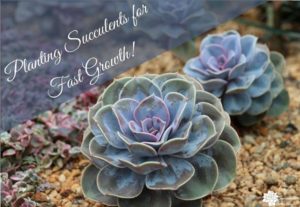You’ve been given a beautiful succulent dish garden for your birthday, anniversary, or promotion. You love it (natch)! You give it plenty of light, not too much water, and it thrives. So exciting, isn’t it? It’s growing!
And growing…
And growing… and in several months, it’s not looking really so great anymore… The only “downside” of succulent dish gardens as gifts or for yourself is that they do grow. But you can rejuvenate that overgrown succulent arrangement and get it looking fabulous again. I’m going to show you how!
How Long Will a Succulent Dish Garden Last?
In this Post We'll Cover:
- How Long Will a Succulent Dish Garden Last?
- Rework Overgrown Succulent Dish Garden
- Clean Up Succulent Dish Garden
- Divide Overgrown Succulents
- Separate Overgrown Succulents
- Replanting the Succulent Dish Garden
- Adding Plants to the Succulent Arrangement
- Consider Succulent Dish Garden from All Angles
- Succulent Dish Garden Care
{Please note, some links in this post may be affiliate links to sites that pay me a small commission if you click on the link and make a purchase. This commission is at absolutely no cost to you. I only recommend products and companies that I have worked with and truly love! ~Kat}
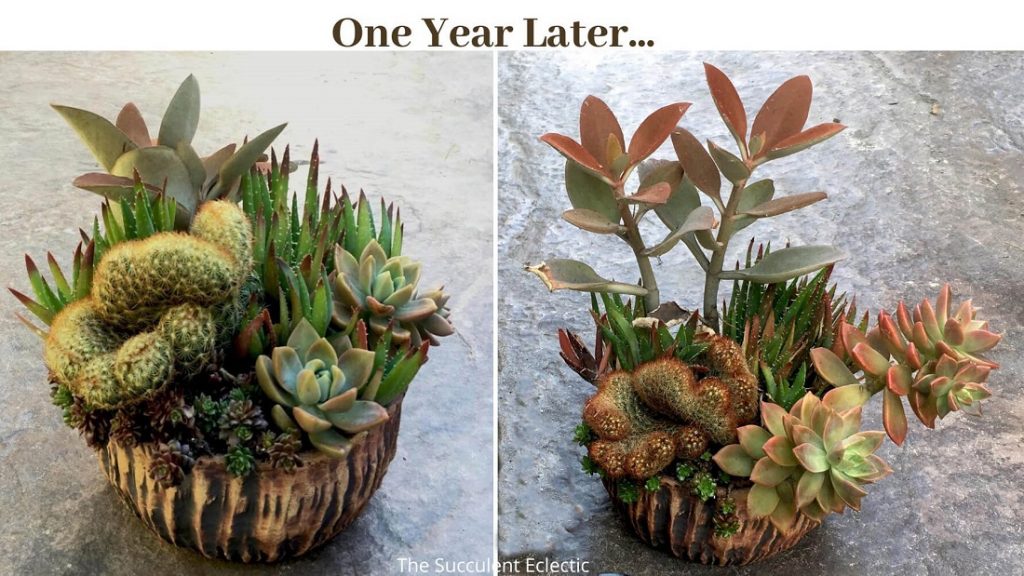
Regular readers know I just love close-planting succulents for dish gardens and arrangements! Unlike most plants, succulents will happily grow crowded with others. The effect of a tightly planted succulent arrangement is a lush, full look right away, without waiting for the plants to “fill in.” People invariably ask, “how long will it last?” I planted the succulent dish garden on the left a year ago (almost to the day). Look how much the sun brought out gorgeous coloring in the succulents since that time!
This was my very first attempt at an artistic succulent arrangement following the guidance of Cindy Davison, succulent designer extraordinaire. (Join our new Facebook group to learn all about succulent design with Cindy and care with me!) I was inspired by getting my very first Susan Aach pot. Her gorgeous, handmade ceramic pottery is awesome for succulents. Read about my meeting with Susan Aach to discuss her work here.
I was so pleased with how this arrangement turned out! I was inspired by the gorgeous pot, its colors, and textures, and I included plants in the design that were perfect together with each other and the pot, even though I knew at least one would be a fast grower. The gorgeous Graptosedum ‘California Sunset’ had a lovely rosette shape and color for the plants I used. I knew it would be the first to outgrow the succulent dish garden. I had not realized that the Kalanchoe orgyalis ‘Copper Spoons’ would be just as fast to outgrow the arrangement. Still, in all, I think it has held together well for an entire year. But now, it’s sufficiently overgrown for me to show you how to rework it.
Rework Overgrown Succulent Dish Garden
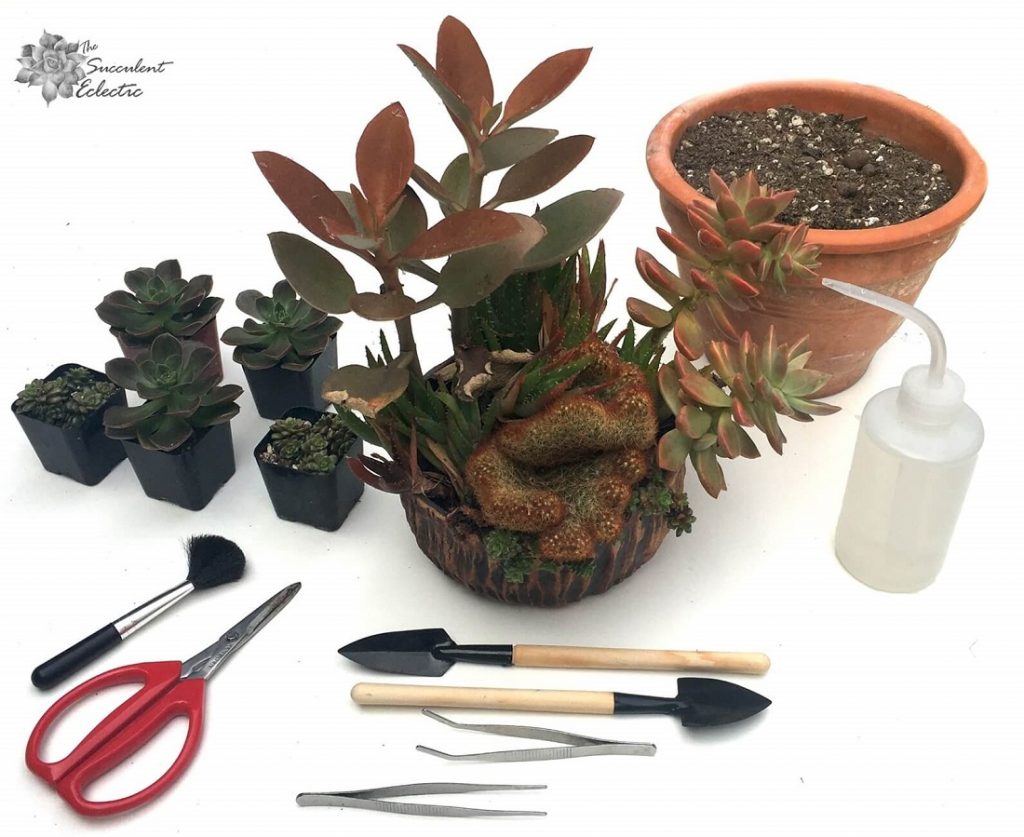
I knew I wanted to replace the overgrown Kalanchoe and the Graptosedum with plants that wouldn’t grow so tall or so quickly. (But look at the color of those Graptosedum!) I also decided to change the color palette a bit. Rather than the cinnamon color, I chose plants that would bring out the dark chocolate color of the pot. I chose Echeveria ‘Melaco’ which develops a deep, molasses color with sun exposure. Then, I took some large cuttings of a Kalanchoe tomentosa ‘Chocolate Soldier’ that has dark brown markings on its leaves to take the place of the Copper Spoons. And I picked up some additional Cremnosedum ‘Little Gem to fill in some spots as I go.
I use the tweezers, small trowels, and soft brush that come in my favorite set of succulent tools to clean up the plants. The tweezers are ideal for removing dead leaves near or on the cactus. The trowels let me get in among the roots and plants. The brush is what I use to dust loose soil from the succulents. The super sharp Joyce Chen scissors are perfect for taking cuttings. The squeeze water bottle is how I water my succulent dish garden to get the water right where it needs to go. And, of course, you’ll need fast-draining succulent soil for planting your succulent dish garden.
Clean Up Succulent Dish Garden
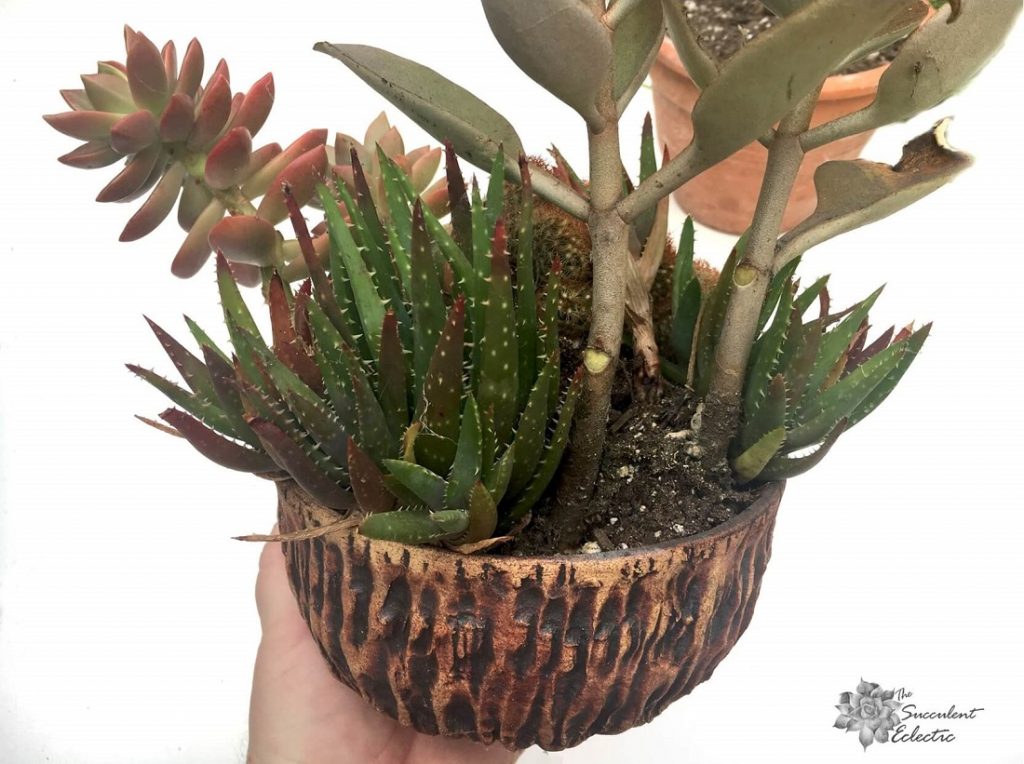
First, clean up the overgrown succulent dish garden. Remove any dead leaves and cut back broken stems. Determine what plants you plan to keep and which you want to replace.
Notice how the sides of this container are straight up and down? This shape enables the plants to come out of the container easily without damage to the roots. When choosing succulent pots, remember to look for a V or a U-shaped pot with straight sides to make transplanting easier. With this kind of pot, remove the entire overgrown succulent arrangement as a whole from the container.
Divide Overgrown Succulents
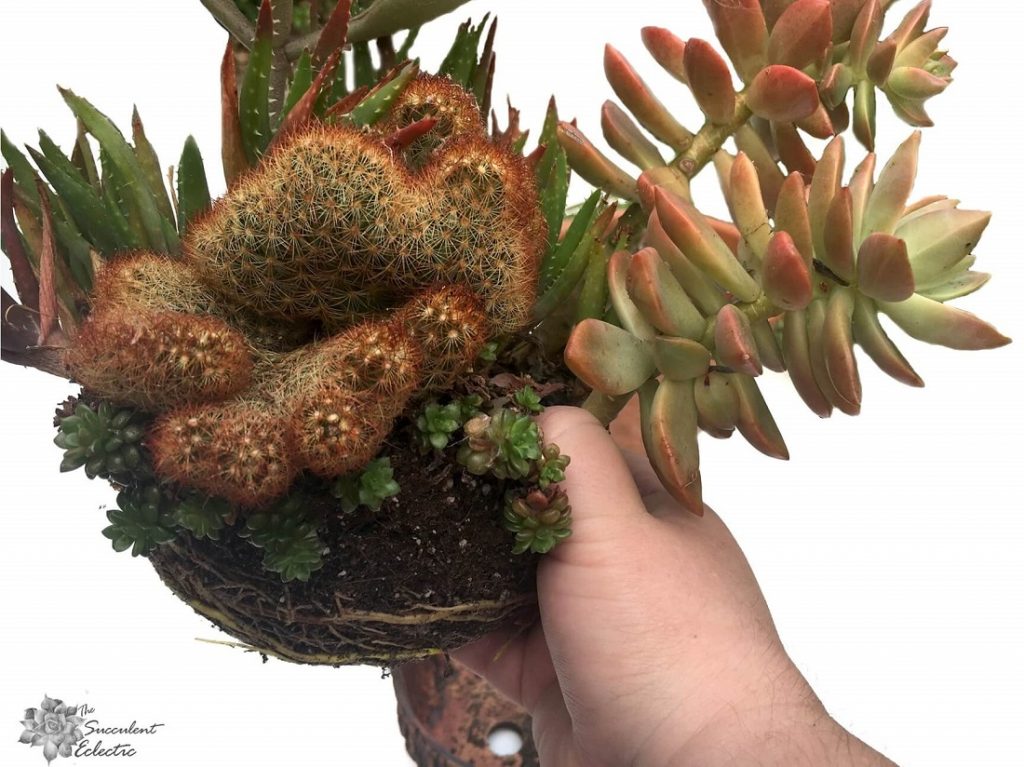
I left this succulent dish garden to dry for several days before working on it, to make it easier to handle. The entire group of plants slid out easily as a single unit. See the roots that wrap around in the shape of the pot? I’ll tease those apart when I replant these succulents. First, I’m using my thumbs to dig into the soil and roots to separate out the Graptosedum. Be gentle but firm. The goal is to separate the plants while keeping the roots intact. Some roots may break, but we want to keep that to a minimum. Go slow and persuade the plants apart rather than ripping them apart.
Then, I’ll do the same with the Kalanchoe and the Aloe ‘Crosby’s Prolific’. Set each plant aside for replanting. Just because they make this look like an overgrown succulent arrangement, they can still be planted on their own or in a new dish garden.
Separate Overgrown Succulents
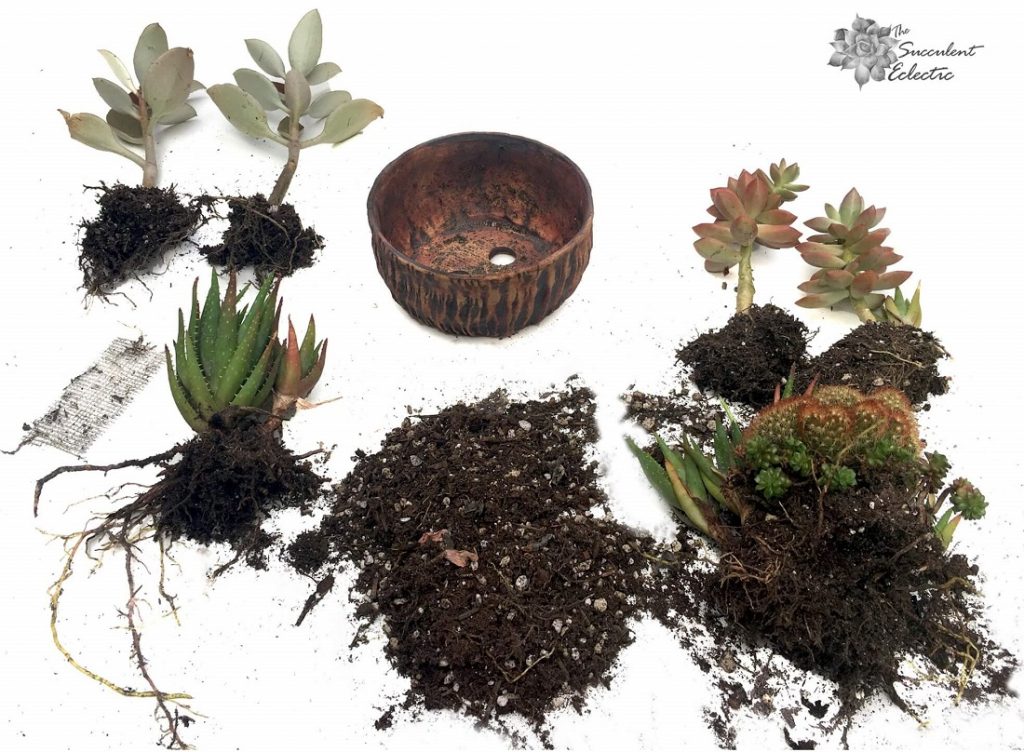
Once you’ve divided all the plants in the succulent dish garden, take a good look at what you have. Remove any overgrown succulents, and any broken or weak stems or roots. We’ll only replant healthy, happy succulents in the original container. The overgrown succulents, cuttings, and loose leaves should be set aside to propagate new plants. Once the succulents are divided, continue to remove excess soil from the roots. Set aside the used soil and replace it with fresh, fast-draining succulent soil. I also worked some dry worm castings into the soil to deter pests.
I really like the way the Mammillaria elongata ‘Copper King’ cristata — the copper-colored crested cactus — nestles in among a few of the Aloe and the Cremnosedum. I’m going to continue that part of the arrangement’s original design.
On the left, you see the mesh drywall tape I like to use to cover the large drainage holes in the pot. I’ll just reuse the same piece when I replant the succulent arrangement.
Replanting the Succulent Dish Garden
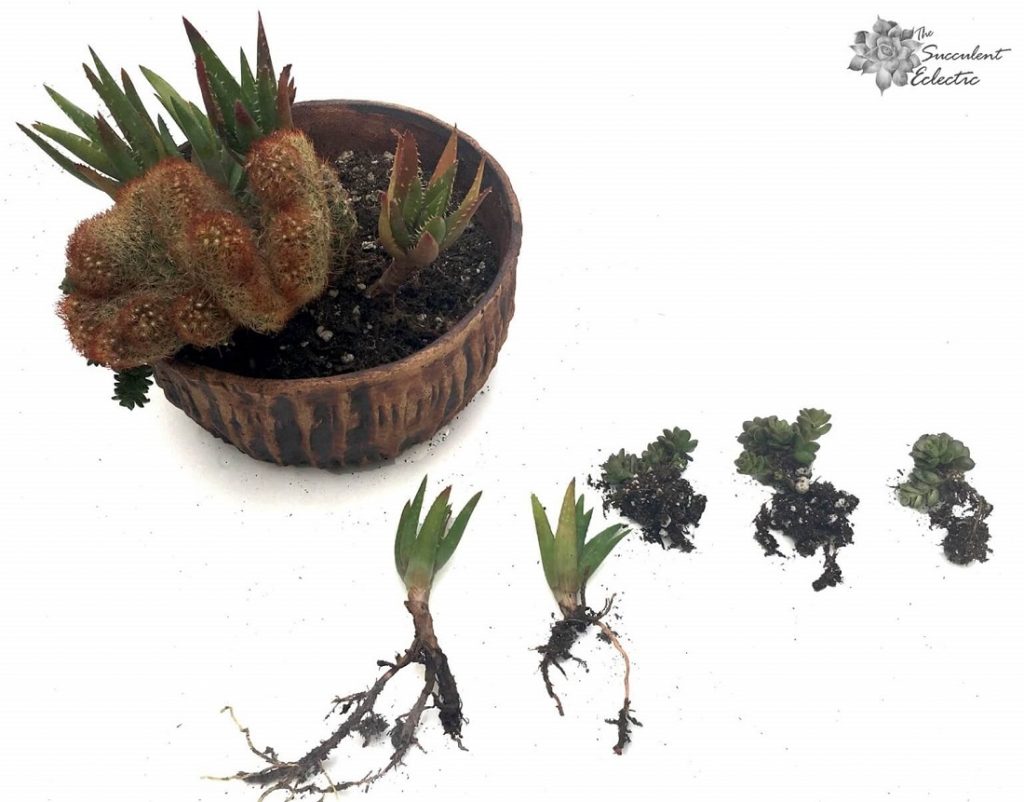
I added fresh soil to the pot and started replanting the succulent dish garden. I always start with the largest components first. Spread the roots of the succulent out and downward as you plant them. Use loose soil to support the roots and keep them spread as you plant. I placed the cactus, with its root ball elevated partway out of the soil, with some of the Aloe framing it. I’ll use these smaller Aloe and Cremnosedum plants to fill in as I go. Note the degree to which the old soil has been removed from the roots. Aloe plants have thick, robust roots. I left a bit more soil attached to the fine, delicate roots of the Cremnosedum.
As you plant the succulent arrangement, the plants will lean this way and that. Don’t worry. Firm up the soil around the roots as you go. The soil and the addition of the rest of the plants will keep them in place.
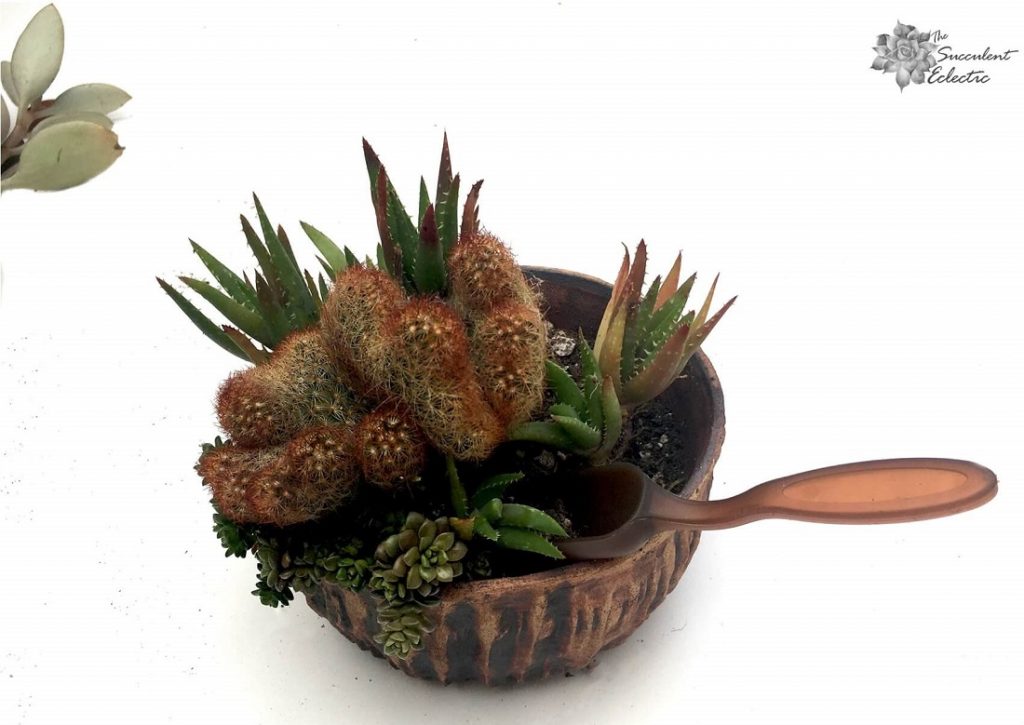
I used the handy scoop that comes in my favorite succulent tools kit to get the soil right in among the roots and between the plants right where I need it.
Adding Plants to the Succulent Arrangement
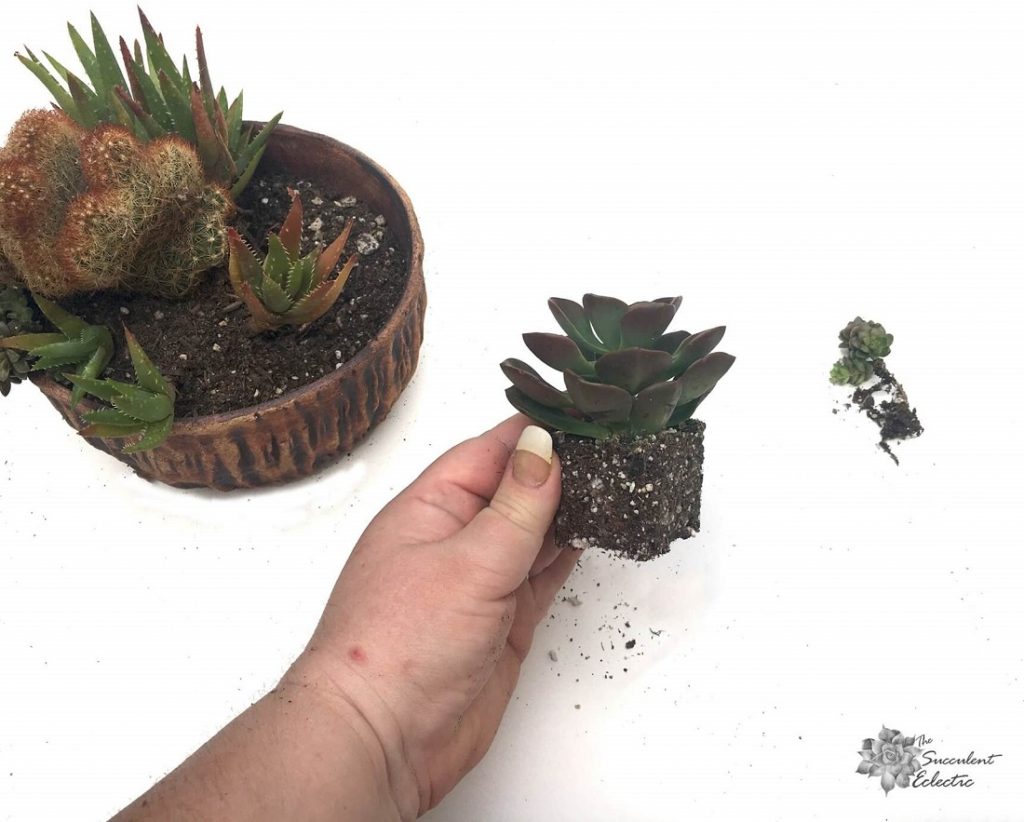
When I remove the first Echeveria Melaco from its pot, the soil maintains the shape of the pot. Clearly, if I leave the root ball and soil intact, I’ll never be able to plant this succulent dish garden as closely as I would like.
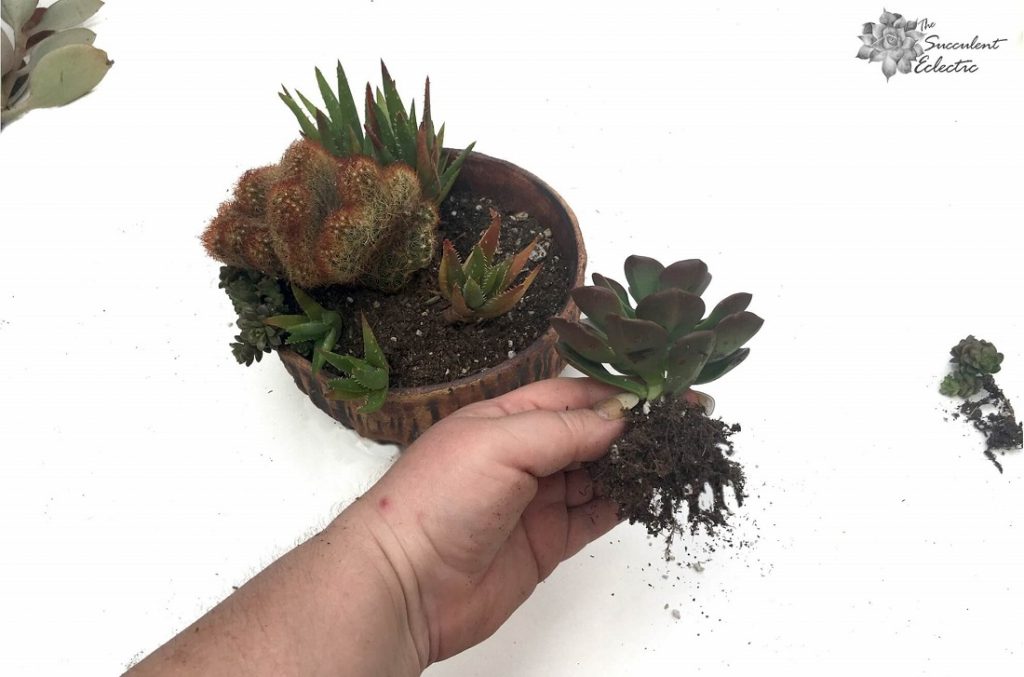
Again, I remove the excess soil and loosen up the roots of the plant. This allows me to tuck the Echeveria in close beside the Aloe plants and the crested cactus.
Consider Succulent Dish Garden from All Angles
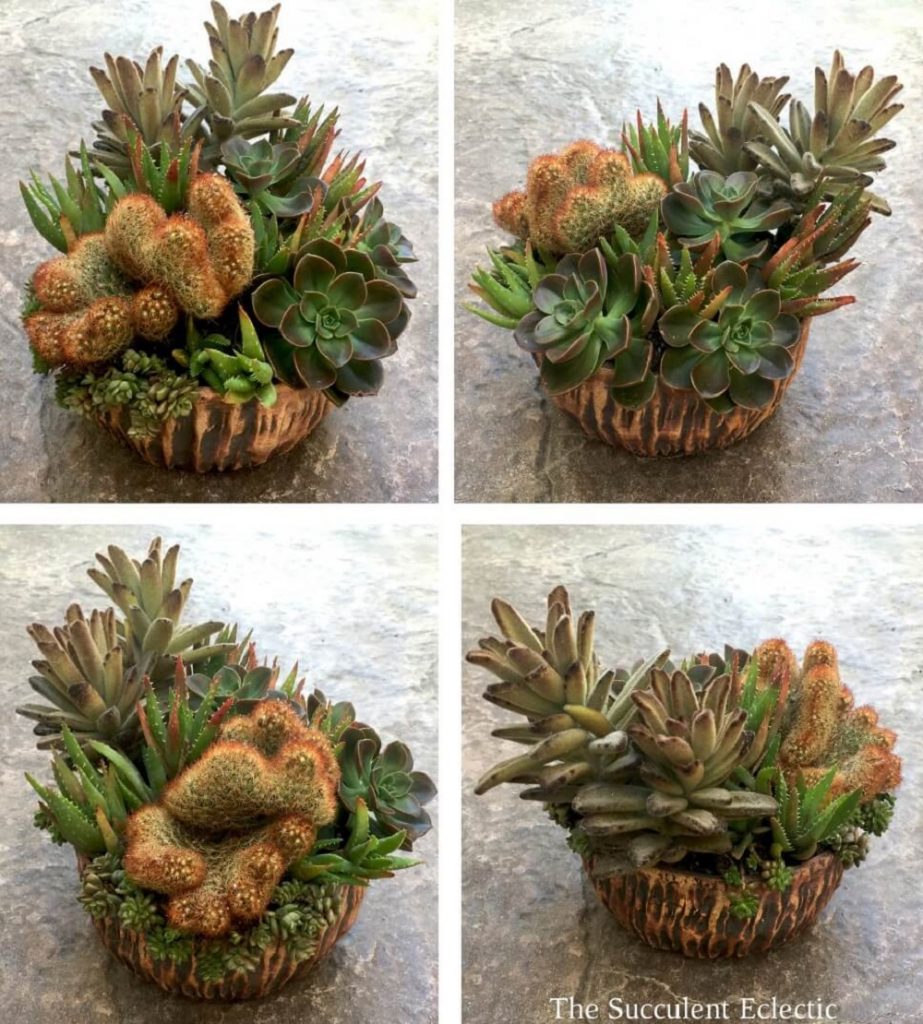
Continue to fill in the succulent arrangement. Be sure to turn the pot as you go. You want the dish garden to look great all the way around. Cindy always uses a lazy Susan as she designs and plants to make this easier.
Succulent Dish Garden Care
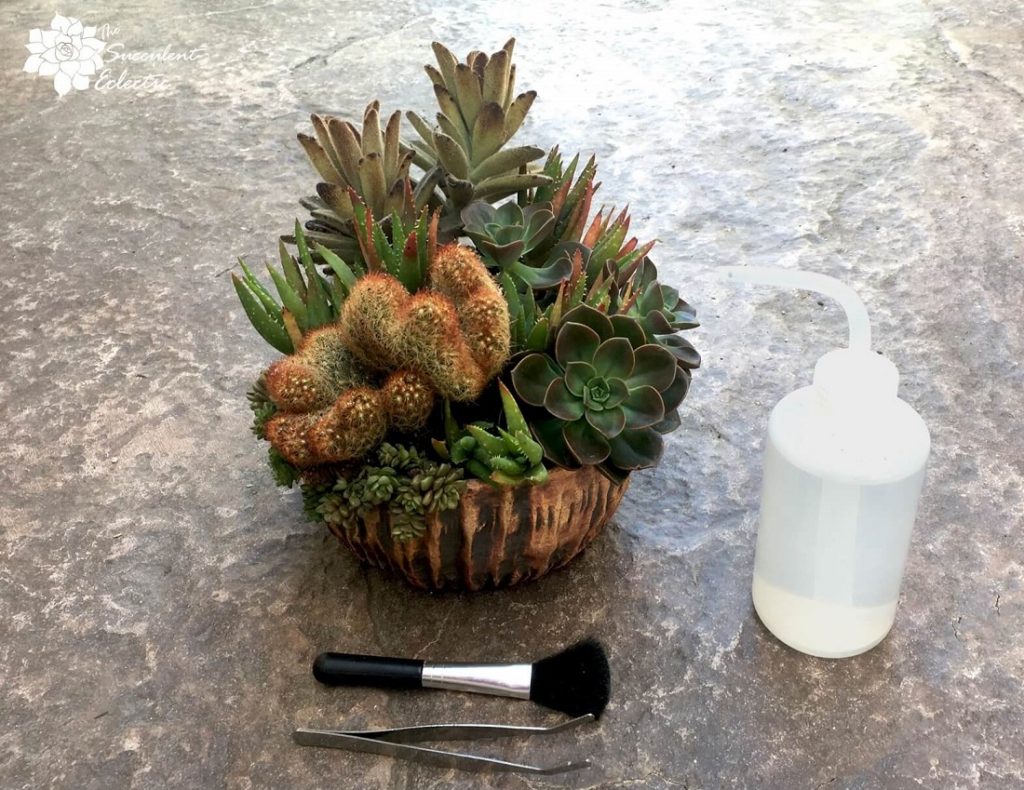
I am so pleased with how this succulent arrangement turned out! Here, you see the tools I’ll use to keep it looking its best. The soft-bristle brush allows me to dust away loose soil, cobwebs, and dust from the leaves of the plants. The tweezers are perfect for plucking dried leaves out or removing cobwebs (we have a lot of spiders!) from the cactus. And my trusty squeeze water bottle — I couldn’t do without it! It allows me to direct water right to the roots where I need it.
I expect this succulent dish garden to last even longer than the year the first one did. The Echeveria Melaco will get larger but not a lot taller. I do expect it to get even darker as I expose it to more sunlight. Eventually, the Kalanchoe tomentosa ‘Chocolate Soldier’ will grow taller as well as wider. But starting as cuttings will keep this from happening too soon. Also, I can take cuttings from the top of this variety to keep it shorter without ruining the shape of the plant. I also expect the Cremnosedum ‘Little Gem’ and the Aloe ‘Crosby’s Prolific’ to develop more color along with the Echeveria.
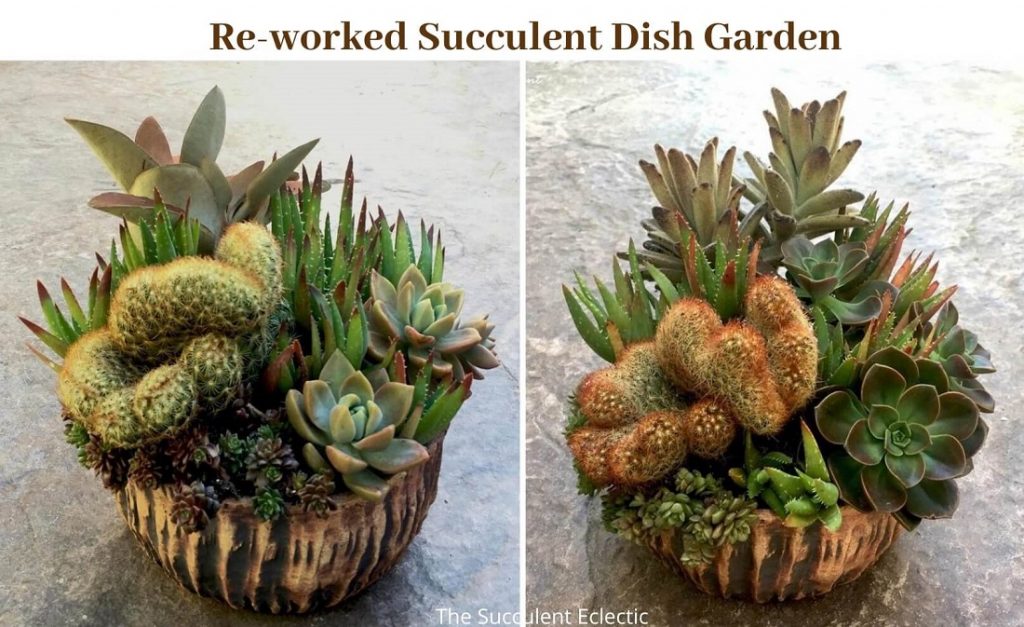
As you can see, I followed the idea of my original succulent arrangement design. I love the copper color that the cactus has developed with more sunshine!
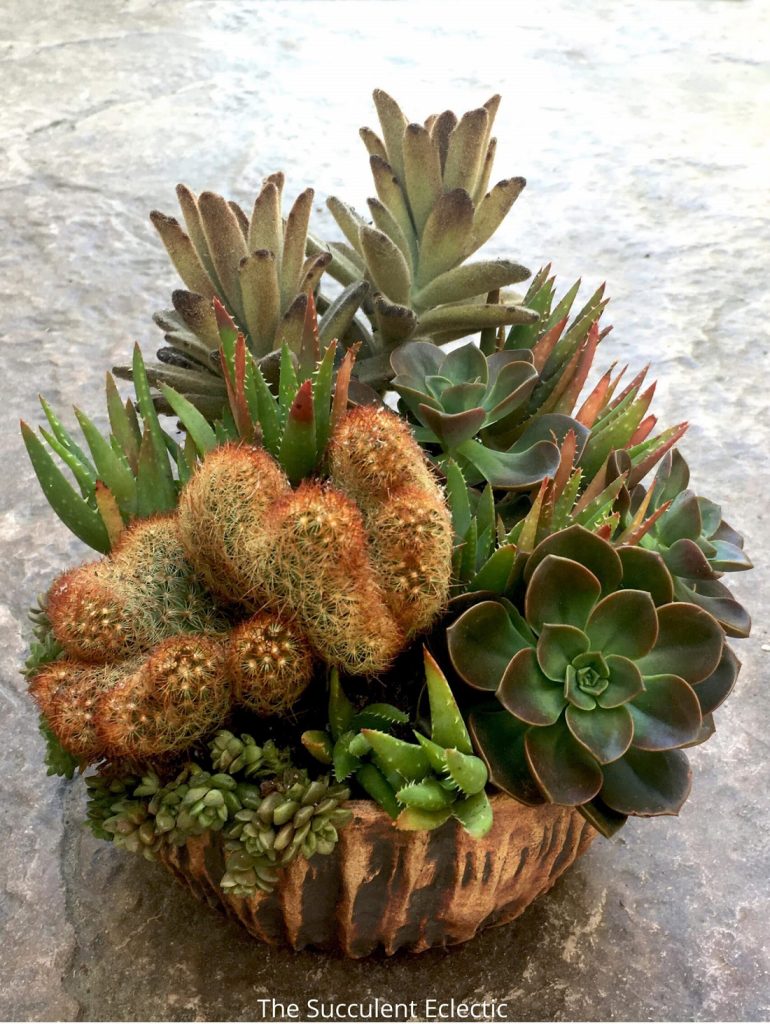
What do you think? Do you feel ready to rejuvenate your own overgrown succulent dish garden? Please take a moment to leave a comment and let me know. You can do this — I promise! To learn more about Cindy Davison’s succulent design techniques, join us in our new Facebook group for succulent-lovers. We cover succulent design, care, crafts, and more. We would love to see you there!
Because life is just better with succulents!

P.S. For more information about all things succulent, please subscribe to The Succulent Eclectic. You’ll receive my FREE e-course, 7 Steps to Succulent Success! Thanks!
P.P.S. Why not join my Facebook Group for succulent lovers? We talk about succulent care, propagation, succulent identification, and design. It’s a warm and welcoming group that would love to meet you!
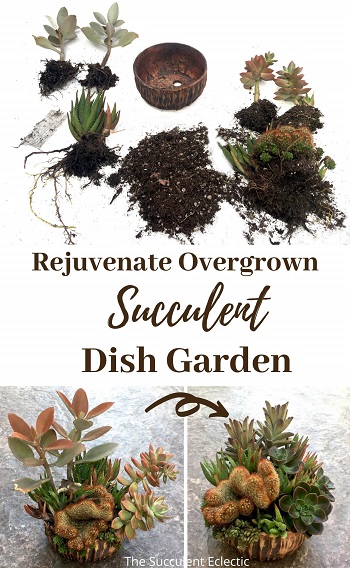
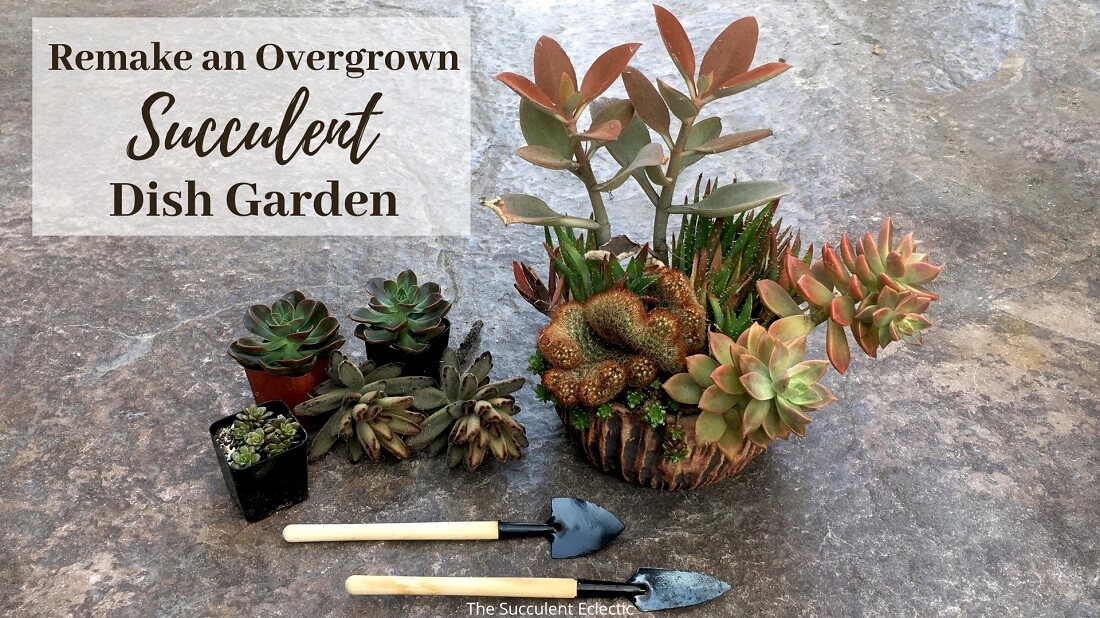
![Read more about the article How Much Light do Succulents Need? + [Infographic]](https://thesucculenteclectic.com/wp-content/uploads/2020/10/how-much-light-do-succulents-need-300x193.jpg)
